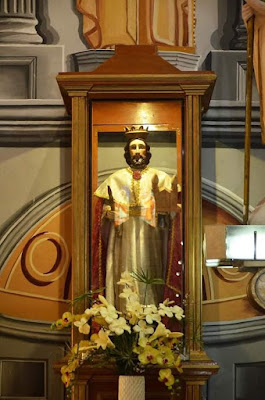San Fernando de Lucena - The Patriarch of Lucena
 |
| San Fernando de Lucena |
The Life of St. Ferdinand, King of Spain
Ferdinand III of Castile was the son of Alfonso IX, King of Leon, and Berengaria, daughter of Alfonso III, King of Castile (Spain). He was declared king of Castile at age eighteen. Ferdinand was born near Salamanca; proclaimed king of Palencia, Valladolid, and Burgos; his mother advised and assisted him during his young reign. He married Princess Beatrice, daughter of Philip of Suabia, King of Germany and they had seven sons and three daughters. His father (the king of Leon) turned against him and tried to take over his rule. The two reconciled later, and fought successfully against the Moors. In 1225, he held back Islamic invaders; prayed and fasted to prepare for the war; extremely devoted to the Blessed Virgin. Between 1234-36, Ferdinand conquered the city of Cordoba from the Moors. Queen Beatrice died in 1236, and he overtook Sevilleshortly thereafter. He founded the Cathedral of Burgos and the University of Salamanca; married Joan of Ponthieu after the death of Beatrice. He died on May 30th after a prolonged illness, and buried in the habit of his secular Franciscan Order. His remains are preserved in the Cathedral of Seville and was canonized by Pope Clement X in 1671. Ferdinand was a great administrator and a manof deep faith. He founded hospitals and bishoprics, monasteries, chuches, and cathedrals during his reign. Her also compiled and reformed a code of laws which were used until the modern era. Ferdinand rebuilt the Cathedral of Burgos and changed the mosque in Seville into a Cathedral. He was a just ruler, frequently pardoning former offenders to his throne. His feast day is May 30th.
 |
| San Fernando de Lucena |
The origins of San Fernando de Lucena traces back to the foundation of St. Ferdinand Parish was founded by Fr. Mariano Granja, the first Parish priest of Lucena, way back March 1, 1881 then the construction of the church itself started in 1882 and was finished by 1884 and had the image of St. Ferdinand enthroned. Unfortunately, the first church building was destroyed by fire in May 24, 1887 so another church building was rebuilt in its place in November 1887.
It was Monsignor Alfredo Verzosa, then Bishop of Lipa, who paved way for having a diocese here in Lucena when he built a minor seminary in 1942. This seminary became the foundation of building the Diocese of Lucena. On March 28, 1950, Pope Pius XII issued a bull Quo Aeternae Dominici Gregis establishing the Diocese of Lucena and was expedited on May 20, 1950. And on September 8, 1950, the Diocese of Lucena was canonically erected.
The devotion
The devotion to San Fernando of Lucena is observed by the faithful of Lucena with Thursdays dedicated as his devotional day with an offering of masses and veneration of his relics. His feast day, May 30 is celebrated with much solemnity. Being a politician or military personnel can be the context of a holy life as Saint Ferdinand shows. Actually, any reputable profession can be a source of holiness. It all depends on the person’s faith and attitude toward life. May in these modern times learn from his example to do our work, regardless of what profession we have.
San Fernando de Lucena, Ipanalangin mo Kami!
References:
Butler, Alban, "Lives of the Saints", Tan Books, USA, 1999.
"St. Ferdinand Cathedral" Retrieved from http://www.lucenahin.com.ph/st-ferdinand-cathedral/ on June 26, 2020.
Photos:
Caringal, Jib
Special thanks to Mr. Jib Caringal for providing the necessary information and photographs on San Fernando de Lucena for this blogpost.
+AM+DG+





Comments
Post a Comment